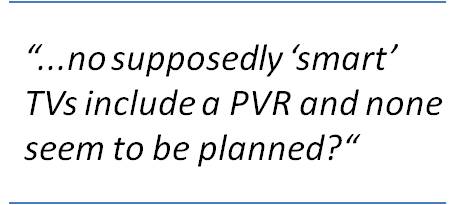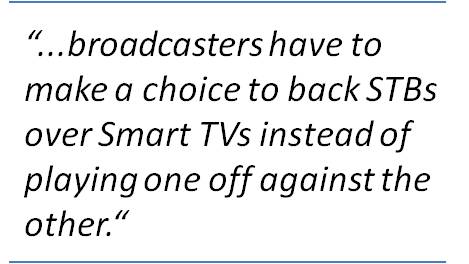As we discussed in our last blog post, we called our Q1 FMRP work ‘A World Gone Crazy’ because the arrival of connected devices has shaken up the traditional TV value chain to an absurd degree. We were trying to chart the potential impact of ‘smart’ screens on the wider TV market, but one aspect kept coming to the fore – the emerging competition between the set top box world and the device world.
There is an assumption in lots of the technology press coverage, that smart screens will eventually drive ‘cord-cutting’ ie a viewer giving up or reducing their pay TV subscriptions. We envisaged a home in this emerging connected world, that had a smart TV screen AND a set top box, and began to question if the consumer ultimately needed both. But this assumes that the functionality of screens and boxes is converging.
However FMRP showed that, in the short term at least, set top box companies and screen manufacturers are on fundamentally different development tracks. There are two separate strands of innovation driving the TV market.
short term at least, set top box companies and screen manufacturers are on fundamentally different development tracks. There are two separate strands of innovation driving the TV market.
The set top box manufacturers (whether for pay or free markets) appear to be driving a much more ‘broadcast-centric’ agenda, while the device manufacturers are, at best, ’broadcast-averse’ in their innovation plans. We believe that this will have a huge impact on the way content is distributed, and it should really concern the broadcasters. It should drive them to make some difficult choices over which route to back, rather than playing one off against the other. To understand this we need to look at the nature of these two innovation strands. Firstly, which innovations do we count as ‘broadcast-centric?
Backwards EPGs are clearly the most broadcast-centric of all the innovations currently hitting the market. At simplest, they give channels the opportunity to deliver on-demand under their own brand. But more importantly, they position catch-up as a ‘complement’ to broadcast not as an ‘alternative’ by keeping the viewer in the EPG rather than driving them over to an app zone. As of this morning, there are three boxes in the UK with a backwards EPG (Tivo, YouView and Freesat+), with more to come. However, there are no connected/smart TV screens offering one. Most smart TVs offer a simple Freesat / Freeview EPG with limited functionality. There aren’t even any in development in the TV screen world. In fact the device manufacturers seem to be ignoring the EPG when it comes to investing in innovation.
A second broadcast centric feature would be IP-streamed channels that sit in the EPG. This is the mechanism by which ConnectTV delivers multiple channels into the DTT EPG (but not currently the DSat one). It allows smaller, niche IP delivered channels to fit into the broadcast line up, with all the other linear content, rather than being forced into an app area. Once again, it is a ground breaking, IP-based innovation that supports the core channel model rather than competes with it. Including this capability is now mandatory for any UK television device (iDTV or set top box) that wants to conform to the DTG’s 2011 D-Book spec. Once again, rather than embracing it, most smart screen manufacturers were given an exemption from including it until this year. Even now, its inclusion is patchy.
It may seem counter intuitive, but we also consider PVRs to be a broadcast centric function. They certainly can’t exist without broadcast delivery of programmes and they allow playback of the original show with the original advertising (although this may change as PVRs evolve). PVRs are obviously at the heart of most set top box innovation, even to the point of being integrated with VOD as in SkyAnytime+ (see our blog ‘PushVOD is the new Pull VOD).
However, PVR innovation has stalled a bit in recent years, as catch-up took up all the platforms development time, but we anticipate it returning to the fore as set top boxes continue to evolve. For instance, in YouView you can find your recorded programmes via the backwards EPG as well as the catch-up ones. However, no supposedly ‘smart’ TVs currently include a PVR. Most allow an external hard drive to be added via USB.  However, with a single tuner and a DLNA folder structure, our FMRP consumers found these almost unusable. One would have thought that a home network based PVR and multiple tuners would have been on the device roadmap, but there is no sign of them yet from any smart screen manufacturer.
However, with a single tuner and a DLNA folder structure, our FMRP consumers found these almost unusable. One would have thought that a home network based PVR and multiple tuners would have been on the device roadmap, but there is no sign of them yet from any smart screen manufacturer.
The final broadcast-centric area of innovation is broadcast interactivity. Red button is a broadcast functionality that has refused to die in the UK, with the high usage figures for the BBC’s recent Olympics and Sky’s Formula1 coverage demonstrating both healthy supply and demand. There are interactive innovation projects underway in various parts of the UK content industry (eg Fuel4 and BBC Connected Studio), and Sky, Freesat, Freeview and Youview have continued to support it. Virgin Tivo is gradually getting it place after initially omitting it. But most ‘smart’ TV screen manufacturers were taken aback when UK broadcasters asked to link to their player apps from the red button. They hadn’t considered this basic level of functionality as relevant, let alone the next generation of broadcast / on-demand integration. It is likely that the next generation of broadcast content innovation won’t playout on supposedly ‘smart TVs’ at all.
So if that is the broadcast-centric stuff, what counts as a ‘broadcast-averse’ approach to innovation. A simple, trite answer would be any device that doesn’t include most or all of the above. But in reality there is a cultural issue in play. To be broadcast-centric, a device manufacturer has to both value broadcast, and believe its future is central to the TV experience. This clearly isn’t the case in the broader smart device world, where the cult of the app predominates. Most smart TV manufacturers are interested in capturing the value that they see being created by Apple, and Google in the app world, not in driving consumers back to a part of the TV experience where they have no way of capturing revenue. They are therefore interested in supporting a broadcasters player app, but can see no potential revenue in helping to drive people back linear broadcast.
A second part of the problem for smart TVs is the manufacturers ‘one-size fits all’ approach. They want to sell the same product in as many markets around the world, with as little localisation as possible. Broadcast, however, needs to conform to local standards and to local regulatory frameworks. Most broadcast innovation requires integrating local innovation standards. Red button rolled out differently in every country around the world despite the best efforts of the MHEG community. These issues mean incremental cost in each country, with no visible incremental revenue. Another reason why the next generation of interactive content will struggle to be seen on smart TVs
Who Cares?
Thus we have these two separate strands of TV innovation leading to significantly different outcomes. One leads to a new device centric TV world, built around on-demand, movie streaming services, and apps. The other – whilst driving new innovation around on-demand and other IP functionality – still has broadcast at its core.
For the free and pay platforms, smart TVs are clearly a direct competitor but one with an interesting twist. In the first instance, the platforms need to make sure that anything truly useful on a smart TV is also available through their STB. As highlighted in our previous blog- this means the FTA player apps and good on-demand movie provision. The twist is that, beyond that point, the STB platforms can exploit everything the device manufacturers make. It is likely that the most useful connected apps that will in the next few years, will come from Sky and Virgin, YouView and Freesat. Through clever app development, every smart screen could become an extension of a STB based proposition.
For broadcasters, it is a more complex set of calculations In a home with a STB and a smart TV, should a broadcaster care which device a consumer uses to access its content? Decipher believe that it comes back to the core question of whether broadcasters still value broadcast as the core delivery mechanism. Unless you are the BBC, then it is commercial suicide to not value broadcast ove r on-demand consumption. Broadcast is where they make their money. The broadcasters have yet to confront the difficult idea that they may have to choose which camp to play in. . They will have to support the STB service companies, but reducing or withdrawing investment in apps on devices. However, this assumes that the right people get to make the decisions within the broadcasters.
r on-demand consumption. Broadcast is where they make their money. The broadcasters have yet to confront the difficult idea that they may have to choose which camp to play in. . They will have to support the STB service companies, but reducing or withdrawing investment in apps on devices. However, this assumes that the right people get to make the decisions within the broadcasters.
We have previously made the point that we think it is dangerous for broadcasters to let their player teams make significant distribution decisions that affect the whole company (See: ‘Who gave the IT department a f *%”ing brand to play with?’). This is exactly the kind of decision we were talking about. The decision over whether to favour STBs over devices (and, by definition, broadcast over players) needs to be made by people demonstrating two attributes: they need to be willing to restrain the player teams for the benefit of the broader organisation; and they need to understand the question in the first place. There aren’t many of those at senior levels in the broadcast industry.
Nigel Walley
Nigel on Twitter @nwalley
Decipher on Twitter @DecipherOffAir
